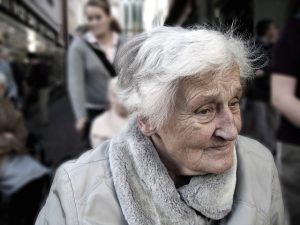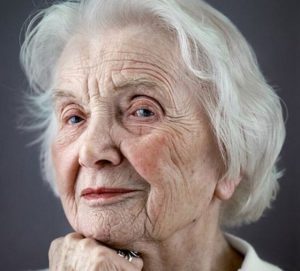News & Articles

Talking to Children About Dementia
By Kristi Beck
Holidays are a time for reconnecting with loved ones. For those with Alzheimer’s Disease or other types of dementia, it may be disorienting to be taken out of a familiar setting—especially if they are now living in a care community. Holiday gatherings can look a little different as multiple generations visit the actual community, versus taking a loved one home for the holiday.
One missed opportunity that I have seen over the years is not preparing children before they visit a grandparent or older adult living with dementia. Parents might think if you don’t discuss this painful disease, you’re protecting your children or that certain behavior can be dismissed as “old age” or forgetfulness. Parents may forget that children will be observing other residents, in addition to the one they are visiting, and those residents will be drawn to their joy and energy.
Remember that children are very insightful and curious. They will ask questions and worry when a grandparent’s behavior changes or when he or she seems absent from their lives. Children might feel nervous around the older adult, especially if he or she is having trouble remembering names or can no longer take care of him or herself the way they once did.
Some suggestions for preparing a child for a visit:
- Be honest and explain the disease. Let them know that Alzheimer’s Disease and dementia does not affect kids and it mostly happens to people over 65 years old. Scientists have discovered medicines that seem to slow the disease down and there’s hope that someday there will be a cure. Age-appropriate information, explaining the disease can be found on such sites as https://kids.alzheimersresearchuk.org/young-kids/
- Encourage children to “go with the flow.” The older adult or grandparent may have an altered sense of reality and arguing or trying to correct him or her might lead to more confusion or agitation. For example, “Grandma sometimes calls me mother.” Explain to children it’s an opportunity to pretend or use their imaginations, but not to argue.
- Prepare ahead of time for “taboo” topics. If you are aware of a particular item of discussion that will elicit emotions, explain it before the visit. “Aunt May gets sad when we talk about her dog Taffy who lives with us.” “Grandpop wasn’t safe driving, so we told him his car is getting fixed at the shop, so he isn’t worried every day.”
Consider meeting in the lobby area or reserving a private dining area for your holiday visit. The Village at Sydney Creek has plenty of space for meeting one-on-one with a resident, including our lobby with fireplace, family room, Activity Room, conference room or one of our lush garden spaces.
Contact Sydney Creek at 805-543-2350 if you are interested in having a staff member visit your child’s schools or club to explain more about Alzheimer’s Disease and dementia.
Suggested Resources:
“About my Grandfather, About My Grandmother” an online video produced by the Alzheimer’s Association
“Really and Truly,” by Emilie Rivard
“Grandma and Me: A Kid’s Guide for Alzheimer’s and Dementia,” by Mary Ann Drummond and Beatrice Tauber Prior
On a lighter note: “Why Did Grandma Put Her Underwear In The Refrigerator?” Max Wallack, Carolyn Given

Understanding Dementia 
Following is a list of symptoms, causes, and conditions taken straight from the Mayo Clinic website.
Overview
Dementia isn’t a specific disease. Instead, dementia describes a group of symptoms affecting memory, thinking and social abilities severely enough to interfere with daily functioning.
Though dementia generally involves memory loss, memory loss has different causes. So memory loss alone doesn’t mean you have dementia.
Alzheimer’s disease is the most common cause of a progressive dementia in older adults, but there are a number of causes of dementia. Depending on the cause, some dementia symptoms can be reversed.
Symptoms
Dementia symptoms vary depending on the cause, but common signs and symptoms include:
Cognitive changes
- Memory loss, which is usually noticed by a spouse or someone else
- Difficulty communicating or finding words
- Difficulty reasoning or problem-solving
- Difficulty handling complex tasks
- Difficulty with planning and organizing
- Difficulty with coordination and motor functions
- Confusion and disorientation
Psychological changes
- Personality changes
- Depression
- Anxiety
- Inappropriate behavior
- Paranoia
- Agitation
- Hallucinations
When to see a doctor
See a doctor if you or a loved one has memory problems or other dementia symptoms. Some treatable medical conditions can cause dementia symptoms, so it’s important to determine the underlying cause.
Causes
Dementia involves damage of nerve cells in the brain, which can occur in several areas of the brain. Dementia affects people differently, depending on the area of the brain affected.
Dementias are often grouped by what they have in common, such as the part of the brain that’s affected or whether they worsen over time (progressive dementias). Some dementias, such as those caused by a reaction to medications or vitamin deficiencies, might improve with treatment.
Progressive dementias 
Types of dementias that progress and aren’t reversible include:
- Alzheimer’s disease.In people age 65 and older, Alzheimer’s disease is the most common cause of dementia.
Although the cause of Alzheimer’s disease isn’t known, plaques and tangles are often found in the brains of people with Alzheimer’s. Plaques are clumps of a protein called beta-amyloid, and tangles are fibrous tangles made up of tau protein.
Certain genetic factors might make it more likely that people will develop Alzheimer’s.
- Vascular dementia.This second most common type of dementia occurs as a result of damage to the vessels that supply blood to your brain. Blood vessel problems can be caused by stroke or other blood vessel conditions.
- Lewy body dementia.Lewy bodies are abnormal clumps of protein that have been found in the brains of people with Lewy body dementia, Alzheimer’s disease and Parkinson’s disease. This is one of the more common types of progressive dementia.
- Frontotemporal dementia.This is a group of diseases characterized by the breakdown (degeneration) of nerve cells in the frontal and temporal lobes of the brain, the areas generally associated with personality, behavior and language.
As with other dementias, the cause isn’t known.
- Mixed dementia.Autopsy studies of the brains of people 80 and older who had dementia indicate that many had a combination of Alzheimer’s disease, vascular dementia and Lewy body dementia. Studies are ongoing to determine how having mixed dementia affects symptoms and treatments.
Other disorders linked to dementia
- Huntington’s disease.Caused by a genetic mutation, this disease causes certain nerve cells in your brain and spinal cord to waste away. Signs and symptoms, including a severe decline in thinking (cognitive) skills usually appear around age 30 or 40.
- Traumatic brain injury.This condition is caused by repetitive head trauma, such as experienced by boxers, football players or soldiers.
Depending on the part of the brain that’s injured, this condition can cause dementia signs and symptoms, such as depression, explosiveness, memory loss, uncoordinated movement and impaired speech, as well as slow movement, tremors and rigidity (parkinsonism). Symptoms might not appear until years after the trauma.
- Creutzfeldt-Jakob disease.This rare brain disorder usually occurs in people without known risk factors. This condition might be due to an abnormal form of a protein. Creutzfeldt-Jakob disease can be inherited or caused by exposure to diseased brain or nervous system tissue.
Signs and symptoms of this fatal condition usually appear around age 60.
- Parkinson’s disease.Many people with Parkinson’s disease eventually develop dementia symptoms (Parkinson’s disease dementia).
Dementia-like conditions that can be reversed
Some causes of dementia or dementia-like symptoms can be reversed with treatment. They include:
- Infections and immune disorders.Dementia-like symptoms can result from fever or other side effects of your body’s attempt to fight off an infection. Conditions such as multiple sclerosis that result from the body’s immune system attacking nerve cells also can cause dementia.
- Metabolic problems and endocrine abnormalities.People with thyroid problems, low blood sugar (hypoglycemia), too little or too much sodium or calcium, or an impaired ability to absorb vitamin B-12 can develop dementia-like symptoms or other personality changes.
- Nutritional deficiencies.Not drinking enough liquids (dehydration); not getting enough thiamin (vitamin B-1), which is common in people with chronic alcoholism; and not getting enough vitamins B-6 and B-12 in your diet can cause dementia-like symptoms.
- Reactions to medications.A reaction to a medication or an interaction of several medications can cause dementia-like symptoms.
- Subdural hematomas.Bleeding between the surface of the brain and the covering over the brain, which is common in the elderly after a fall, can cause symptoms similar to dementia.
- Exposure to heavy metals, such as lead, and other poisons, such as pesticides, as well as alcohol abuse or recreational drug use can lead to symptoms of dementia. Symptoms might resolve with treatment.
- Brain tumors.Rarely, dementia can result from damage caused by a brain tumor.
- This condition, also called hypoxia, occurs when organ tissues aren’t getting enough oxygen. Anoxia can occur due to severe asthma, heart attack, carbon monoxide poisoning or other causes.
- Normal-pressure hydrocephalus.This condition, which is caused by enlarged ventricles in the brain, can cause walking problems, urinary difficulty and memory loss.
Go to https://www.mayoclinic.org/diseases-conditions/dementia/symptoms-causes/ for more information.

It’s a Honey of a Story
By Kristi Beck
A bountiful “bivouac” of bees came to Sydney Creek Memory Care on the afternoon of September 7th. A visitor alerted us to bees swarming high up in the jacaranda tree located at the front of the building.
Staff members Ann and Mike reached out to the San Luis Obispo County Agriculture Department who provided contact information for the Central Coast Beekeepers Alliance whose members are recognized for relocating bees. Within hours, botanist and beekeeper John Chesnut arrived at Sydney Creek equipped with a bucket pole and a collection box, but surprisingly without a bee protection suit. Chesnut is very comfortable doing what he does and says he is stung almost daily. “Like a lot of allergies, you either get worse or better. I just don’t react to stings,” replied Chesnut. He used lemon balm oil to attract the bees into a collection box and then transport them to his hives. Chesnut estimated that there were approximately 1000 bees.
A “bivouac” is a military term used to describe a temporary camp without tents or cover. In this case, it is when thousands of bees leave their home and set up a temporary location from which they send out scouts to evaluate potential nest sites for the Queen. Bees are generally docile during this process and that can last for 24 to 48 hours. They have neither young nor food to protect, and their defensive instincts are minimal.
Bees and other pollinators play a critical role in producing many of California’s agricultural products and in maintaining a healthy environment. Insecticides, habitat loss and parasites all threaten honey bee populations. Beekeepers are losing bees at higher rates and having to scale back on honey production. For bees to make a comeback, human help is needed. It’s easy to do your part in saving bee populations by planting pollination-friendly plants like the California poppy and using relocation instead of extermination.


Dementia Care Settings Can Enrich Patients’ Lives
By Sandy Morris
Many Alzheimer’s and dementia caregivers feel guilty when making arrangements for a loved one to attend a daycare program or move to a memory care community. It is understandable that they would want to keep their family member in their home, but an important advantage of both of these settings is that they provide life enrichment programs specifically tailored to the needs of people with these diseases. Many of the elements of these programs can also be provided in a home setting, but it can require a lot of dedicated effort.
Gone are the days when treatments for dementia sufferers focused solely on their physical needs. These patients were basically warehoused away to wait for the end of their lives. However, we now know that people with various neurodegereative diseases can benefit from regular exercise, social interaction, creative expression, learning opportunities and spirituality programs.
Reputable care providers and facilities focus on all of these aspects in order to provide patients with the greatest quality of life for as long as possible.
Exercise for mind and body
Exercise is extremely important for individuals with Alzheimer’s and other types of dementia. People who engage in regular physcial activity ten to develop Alzheimer’s later in life, and a healthy routine can actually help slow the progression of the disease. Exercises are also an excellent way to relax and destress as well.
Adult day programs and assisted living facilities typically feature a wide array of physical activity classes. Options can range from a series of simple stretches and movements coupled with breathing techniques to chair yoga. This seated form of yoga is gentle and promotes physical and mental wellness. Participants can sit in a chair to do the poses or stand while using the chair for stability.
Exercise can also provide relief from many other health issues associated with aging, improve muscle strength and cardiovascular health, and reduce the risk of falls. Improved mood, confidence and self-esteem are psychological benefits of staying active also.
If you are a caregiver creating an in-home activity program for a loved one, try to select one that you can also participate in so you can reap these important benefits too. Be sure to check with your loved one’s doctor to ensure the exercises you would like to engage in are appropriate and beneficial for your loved one and yourself.
Cooking and dining
Cooking and food preparation celebrate the joy and pleasure that can come from making and sharing a meal. Besides the obvious importance of nutrition for older individuals, food provides a chance for socialization and an opportunity to reminisce about favorite foods, special occasions and traditional recipes. It is a wonderful way to stimulate the senses.
Day care centers and long-term care facilities often feature simple projects such as baking cookies or making lemonade. Some board and care homes offer residents the opportunity to help with daily meal preparation to the extent they are able. You can also structure some of your in-home cooking routines and recipes to accommodate the participation of your loved one. Everyone enjoys feeling useful and having a sense of purpose.
Simple kitchen projects and recipes are a wonderful way to help dementia patients stay engaged and participate in their care. Not to mention, a loved one who is a finicky eater is more likely to eat well if they have participated in creating their snack or meal.
Creative expression
Research has established that persons with Alzheimer’s and other dementias often experience a spike in creativity. Activities involving creative expression celebrate and encourage imagination involving the arts, poetry and music. Many adult day centers and care communities have an arts and crafts area with structured projects and regularly provide musical entertainment and even poetry readings.
The part of the brain that processes music remains intact in many individuals with dementia, and their reaction to music can be truly profound. Music is a popular way to calm an aggitated or confused loved one and connect with individuals who have difficulty speaking or communicating.
Educational opportunities
It was previously believed that people with dementia could not learn and retain information. Now we know that is not true and that even those who are severely forgetful can still enjoy the experience of learning. There are organizations like Active Minds, which deliver teaching on-site to senior communities that can be customized to each audience on compelling, timely topics. Other providers also offer adaptive computer technology for seniors that can challenge and stimulate cognition and learning with an easy-to-use interface. There are other ways to inspire and educate including reading to your loved one, providing them with audiobooks, or playing with specially designed flash cards and other modified educational equipment.
Spiritual connection
Spirituality has many different meanings for different people. For some, it is a connection with God, or a higher being. For others, it is an experience of awe, focused attention or mental discipline. Having a way to make a spiritual connection can enable a person to find inner peace as they navigate their journey through life. Identify your loved one’s preference, and help them to engage in life-affirming experiences.
Whether you would like to enrich your loved one’s life while in your home or you are considering adult day care or a memory care community, it is important to understand the programs they offer that are designed to enrich the lives of those with dementia. These options are not merely distractions or a method of entertainment. These facilities are specially designed to help our aging loved ones feel useful and involved in life. Matching your loved one’s needs and interests with offered programs can help you both feel confident in whatever type of care plan you choose.
[reprinted from www.agingcare.com]
Olfactory Stimulation and Dementia

By Kristi Beck, Executive Director, Sydney Creek Memory Care
At Sydney Creek, we recognize the importance of non-pharmacological therapy and person-centered, meaningful activities in the treatment of dementia. Olfactory stimulation is a useful tool in addressing both goals. Scent, in the form of aromatherapy, can help elevate mood and reduce agitation, lower blood pressure and pulse rate.
Olfactory stimulation can be used to elicit positive memories and provide a sense of well-being.
Aromatherapy
Lavender is the most popular and widely used scent to calm feelings of anxiety, aggression and agitation. In addition to lavender, we include Bergamot and Yuzu essential oils in our community. Bergamot is a mood elevating and calming oil, also used to relieve insomnia. Yuzu essential oil has been used in Japanese culture for centuries. It is a scent similar to mandarin or grapefruit and its crisp aroma can create an atmosphere that is refreshing, especially during times of worry and tension.
We deliver these oils by placing a few drops in a diffuser or massaging them into the temples of the head or dabbing them on the wrists.
Scents and Memories
Some believe that people with dementia lose their sense of smell or the ability to identify scents. However, it is possible for a scent to trigger a memory without knowing the specific name of the scent and anything that can elicit a positive memory should be a part of the daily life of anyone living with dementia. The scent of Coppertone® sunscreen can instantly transport a person to a relaxing day at the beach, without knowing exactly what the scent is.
A woman shared that scent of patchouli oil always brought her husband back to the summer of 1967 in the Haight Asbury neighborhood of San Francisco; a time when they were young and carefree.
In Sydney Creek neighborhood kitchens, or “hearts of the home”, residents experience comforting smells such as clean laundry and cookies baking.
The sense of smell is often overlooked in creating a personal history of a resident with dementia and providing items for their stay in a community. Families and care providers should consider significant life events of your loved one and scents associated them. Memory Care communities can safely store products, and residents can access them with the assistance of a caregiver. Follow the link for ideas on creating your own personalized scent library for your loved one living with dementia. https://www.pinterest.com/ShareRemember

What Should We Feed Our Brains?


By Susan Stewart
As more and more Americans and people all over the world—24 million at last count—are affected by Alzheimer’s Disease, the search for a cure continues. And while we wait, we work hard to understand, care for, and reduce the suffering of those we love who have dementia. One of the elements being studied is nutrition, the hope being that what we eat can prevent, lessen, or postpone the onset of dementia, and help those already afflicted to have a higher quality of life.
Happily, the preponderance of research on the subject of nutrition and the dementias supports what most of us already know: that a healthy diet can and does help. As a person keenly interested in food, diet, and their relationship to health, I’ve been studying this topic for years. The literature seems to offer some new revelation every few months, often contradicting what came before it. Today we argue the merits of paleo versus veganism, gluten-free versus whole grains, organic versus processed, dairy-free or calcium-rich. It’s confusing, and frustrating. However, the one constant over many decades and across hundreds of experts is that fresh fruits and vegetables, whole grains, and unprocessed meats and dairy are the mainstay of most healthy diets. The other constant is that we should avoid high sugar, white flour, processed, fast, and junk foods. And the same holds true for what we should be eating (and not eating) to either prevent or cope better with dementia.
A quick Google search revealed the latest studies, three of which provide the newest dietary guidelines for supporting brain health and coping with dementia: The National Center for Biotechnology Information, the Cleveland Clinic, and the National Institutes of Health.
Data from several lines of evidence suggest that the relationship between diet and Alzheimer’s Disease (AD) is similar to that between diet and coronary disease. Diets containing anti-oxidant nutrients, fish, dietary fats, and B-vitamins may play a protective role. Omega-3 fatty acids (fish oils) may hold the promise of prevention and treatment, though hard proof has yet been found. Diets that emphasize high levels of B vitamins, especially B12, are suggested, since their lack has been found to cause the kind of brain damage found in AD.
Put more simply, a diet like the Japanese or Mediterranean diet, or any diet high in fish, fruits, and vegetables but low in processed meats, white flours, fried and packaged foods are associated with a lower risk of AD. Nuts and seeds are high in the right kind of fats, especially flax and pumpkin seeds, which are easy to add to salads or cereals. Vitamins C and E are also useful. Coffee (in moderation) has been shown to be related to better brain health. That was great news for this coffee lover, especially because this statistic has not been contradicted in many years.
For a more definitive look at nutrition and brain disease, I humbly refer you to the British Association for Applied Nutrition and Nutritional Therapy, plus a very good book by Patrick Holford: The Alzheimer’s Prevention Plan. Eat well, worry less, and look for pleasure in the little things! # # #

Finding Happiness (not heartbreak) Among the Demented
By Susan Stewart
In a recent article (March 2018 issue of Harper’s Magazine) about caring for people with dementia, author and visiting nurse Sally Tisdale delves into the day-to-day world of real people suffering from the various myriad forms of brain disease. Offering us a rare glimpse of the highly individualized (and often mysterious) responses to their demented condition, Tisdale finds “… a world that is far more nuanced than the commentary surrounding it: there is grace here, rare intimacy, moments of startling clarity—and yes, happiness.”
“The stark fact is that dementia is incurable, progressive, and fatal, but … in the company of the demented, one finds peace and unquestioned love in at least as much measure as in the rest of the world,” she continues.
Where others see only loss and embarrassment and tragedy, “I see the riches: the brave, vulnerable, completely human work of figuring things out,” Tisdale explains. “People with dementia sometimes have a rare entrancement with their surroundings, a simplicity of perception, a sense of wonder.”
“The communal response to dementia seems to invite only existential despair,” she says. “Yet people with Alzheimer’s consistently rate their quality of life higher than their family members do. … people with cognitive impairments were no less happy than healthy people.”
Please read Tisdale’s piece in its entirety at https://harpers.org/archive/2018/03/out-of-time and hear the joy it offers to those affected and those who care for them. I think you’ll agree with her when she concludes: “What a wonder it all is, that we appear and abide and fade away and no one knows what follows.”
Celebrating Our Differences! Racial and Cultural Diversity in Memory Care communities
By Susan Stewart



As we celebrate Martin Luther King Jr. Day during the month of January, we are reminded of the long way we have come and the long road still ahead in achieving the kind of equality Dr. King dreamed of. A cursory glance at Memory Care communities across the nation tells us that while Alzheimer’s Disease does not discriminate along racial lines, the populations living in these communities remain predominantly white.
A Center for Disease Control (CDC) survey found that 91 percent of those living in Assisted Living Communities (and Memory Care is a specialized type of Assisted Living) were Caucasian. That’s a disproportionate number compared to the general population. As our aging population increases, it will be important to finds ways to mitigate this disparity, and ensure that all Americans have access to quality memory care. This is especially important as current research reveals that minorities may be at greater risk for developing dementia.
“As the population of the U.S. ages and becomes more diverse, the burden of dementia may be falling disproportionately on elderly minorities, both in terms of prevalence and severity.” (from The Impact of Ethnoracial Differences in Alzheimer’s Disease by Chin, Negash, and Hamilton)
The authors of the above study admit that the reasons for this are unclear but could include the following: That sometimes both diagnosis and treatment are delayed for minority populations due to social and cultural factors, beliefs about normal versus abnormal aging, lack of adequate access to medical care, and issues of trust between them and the medical establishment.
“I think the biggest piece of the puzzle for some African Americans and some Hispanics comes down to finances,” says Debra Carter of the National Caucus & Center on Black Aging. The entry fee alone can be prohibitive for many minority families, she says, let alone the often pricey monthly fee.
But economics alone does not explain it. Andrea Doherty, a Massachusetts-based senior living expert suggests that it might be as simple as geography. Many assisted living and memory care communities are being built in regions where most people (predominantly white) can support the monthly price tag of placing a loved one, as opposed to lower income inner cities (where a higher percentage of minorities live).
Perhaps the best place to focus our attention, both as professionals in the memory care industry and as consumers, is on each individual community’s ability to welcome and accommodate the wide variety of cultures, colors, and ethnicities growing old in America.
At Sydney Creek, residents reflect the larger community of San Luis Obispo, which is predominantly Caucasian. In the coming years, that demographic will change. Life Enrichment staff are well trained to be inclusive and welcoming to all colors and backgrounds. Recent surveys confirm that Memory Care as an industry is aware of the need to address its increasingly diverse residents, and is working hard across the board to ensure that its staff and communities can meet their differing social and cultural needs. # # #

Thomas Fire Prompts Needed Evacuation and Disaster Preparedness Plans
They are just so unpredictable. Natural disasters come at us out of nowhere, often with very little warning. Recently, 27 residents from Oak Cottage of Santa Barbara, a secured residential memory care community, arrived with caregivers, family, and staff members by bus and car to The Village at Sydney Creek Memory Care in San Luis Obispo. All were evacuees from the Thomas Fire who require specialized care; they arrived with medications, emergency documents, clothing, even a pet cat in a basket.
Mobilizing every member of her staff, Sydney Creek Administrator Kellie Gallegly, was notified in time to coordinate with Long-Term Care Ombudsman Karen Jones who arranged to have enough cots for the emergency arrivals.
“Our Director of Wellness, Kahlua Sievert, was the first to receive the call for help,” said Gallegly. “She notified staff members, including Medical Advisor Dr. Kevin Parzych and his wife. Since then, the team effort has been incredible; not one person has complained about the extra hours; it has been a very smooth process.”
As this blog post is being written it is unclear how long the evacuees will be staying at Sydney Creek but it might be as long as a week or even a month. “The whole community has stepped up to help,” said Gallegly, crediting SLO Health and Fire Departments among many others, for their support. Even nearby hotels offered reduced rates for family members.
All of which is a jarring reminder of the value of being prepared. Many seniors do not live in well-run communities. And some have discovered the hard way that having an emergency plan in place for evacuation is important—even life-saving. So a group of smart seniors living in Rochester, New York, wrote a comprehensive handbook called Disaster Preparedness for Seniors by Seniors. This comprehensive and immensely valuable 20-page booklet can be found (and printed out) at the www.redcross.org. Here are some highlights:
Three Steps to Preparedness: 1. Get a Kit
- Make a Plan
- Be Informed
- The Kit: The disaster supplies kit should be packed and ready, and stored in one place where everyone knows where to find it. It should have enough supplies (food, water, batteries and the like) to last at least three days. Complete list found on the site. For extra ease, the kit could be a container that has wheels. And please, label everything – especially walkers, wheelchairs, canes, etc. Don’t forget to include important documents (copies will do), like your medications and allergies list, deed to house, birth certificates, insurance policies, etc.
- The Plan: Meet with friends, family, and neighbors to construct a plan that everyone agrees to. Arrange for someone to check you on at the time of a disaster. Think about what personal disabilities or limitations that might affect your response to a disaster. Practice the planned actions regularly to make sure it works–the site suggests every six months. You may want to choose an out-of-town contact person as well. Include such things as escape routes and meeting places, a copy of your community’s evacuation procedures, and a review of the safe places within your home in case you are told to shelter in place.
- The Information: Post emergency phone numbers at every phone in your house. Plan for your pets and service animals, and be aware they are not allowed in emergency public shelters for health reasons. Consider where to keep vital family records, hearing aids, and other assistive devices so that they will be less likely to be damaged during an earthquake or flood. Think about the kinds of hazards that could threaten your neck of the woods, both natural and human-caused. Find out how your community warning system works. And know how to reach your local Neighborhood Emergency Team, CERT (Community Emergency Response Team), or community block association.
These three steps are by no means exhaustive so please visit the Red Cross website for the complete handbook. It’s the best gift you can give yourself and those you love this season, because whether it’s fire, flood, or a tragic train derailment – there’s no predicting them. But we CAN prepare for them. # # #
Putting the “Happy” back into Holidays
… Celebrating the season with loved ones who have dementia
By Susan Stewart
Just last week, I wrote an article about the importance of including our elders in our seasonal celebrations, and ways to make sure they are not forgotten in the holiday rush. I was heartened to find that many of the researchers emphasized that special care should be taken with loved ones who suffer from Alzheimer’s Disease and the other dementias. The best advice I found was the following piece from the Alzheimer’s Association (https://www.alz.org/care/alzheimers-dementia-holidays.asp) which contains excellent ideas and resources for support. Enjoy!
(article start) The holidays are a time when family and friends often come together. But for families living with Alzheimer’s and other dementias, the holidays can be challenging. Take a deep breath. With some planning and adjusted expectations, your celebrations can still be happy, memorable occasions.
Check in with the person with dementia
In the early stage, a person with Alzheimer’s may experience minor changes. Some may withdraw and be less comfortable socializing while others may relish seeing family and friends as before. The key is to check in with each other and discuss options. A simple “How are you doing” or “How are you coping with everything?” may be appreciated. Plan the holidays together, focusing on the things that bring happiness and letting go of activities that seem overwhelming or stressful.
For people in the middle or late stages, consider rethinking holiday plans. Everyone is unique and finding a plan that works can involve trial and error.
Familiarize others with the situation
The holidays are full of emotions, so it can help to let guests know what to expect before they arrive.
If the person is in the early stages of Alzheimer’s, relatives and friends might not notice any changes. But the person with dementia may have trouble following conversation or tend to repeat him- or herself. Family can help with communication by being patient, not interrupting or correcting, and giving the person time to finish his or her thoughts.
If the person is in the middle or late stages of Alzheimer’s, there may be significant changes in cognitive abilities since the last time an out-of-town friend or relative has visited. These changes can be hard to accept. Make sure visitors understand that changes in behavior and memory are caused by the disease and not the person.
You may find this easier to share changes in a letter or email that can be sent to multiple recipients. Here are some examples:
“I’m writing to let you know how things are going at our house. While we’re looking forward to your visit, we thought it might be helpful if you understood our current situation before you arrive.
“You may notice that ___ has changed since you last saw him/her. Among the changes you may notice are ___.
“I’ve enclosed a picture so you know how ___ looks now. Because ___ sometimes has problems remembering and thinking clearly, his/her behavior is a little unpredictable.
“Please understand that ___ may not remember who you are and may confuse you with someone else. Please don’t feel offended by this. He/she appreciates your being with us and so do we.”
“Please treat ___ as you would any person. A warm smile and a gentle touch on ___’s shoulder or hand will be appreciated more than you know.”
“We would ask that you call when you’re nearby so we can prepare for your arrival. With your help and support, we can create a holiday memory that we’ll all treasure.”
For more ideas on how to let others know about changes in your loved one, join ALZConnected, our online support community where caregivers like you share tips on what has worked for them.
Adjust expectations
- The stress of caregiving responsibilities layered with holiday traditions can take a toll.Call a face-to-face meeting or arrange for a group discussion via telephone, video chat or email for family and friends to discuss holiday celebrations. Make sure that everyone understands your caregiving situation and has realistic expectations about what you can and cannot do. No one should expect you to maintain every holiday tradition or event.
- Be good to yourself.
Give yourself permission to do only what you can reasonably manage. If you’ve always invited 15 to 20 people to your home, consider paring it down to a few guests for a simple meal. Let others contribute. Have a potluck dinner or ask them to host at their home. You also may want to consider breaking large gatherings up into smaller visits of two or three people at a time to keep the person with Alzheimer’s and yourself from getting overtired. - Do a variation on a theme.
If evening confusion and agitation are a problem, consider changing a holiday dinner into a holiday lunch or brunch. If you do keep the celebration at night, keep the room well-lit and try to avoid any known triggers.
Involve the person with dementia
- Build on past traditions and memories.
Focus on activities that are meaningful to the person with dementia. Your family member may find comfort in singing old holiday songs, watching favorite holiday movies, or looking through old photo albums. - Involve the person in holiday preparation.
As the person’s abilities allow, invite him or her to help you prepare food, wrap packages, help decorate or set the table. This could be as simple as having the person measure an ingredient or hand decorations to you as you put them up. (Be careful with decoration choices. Blinking lights may confuse or scare a person with dementia, and decorations that look like food could be mistaken as edible.) - Maintain a normal routine.
Sticking to the person’s normal routine will help keep the holidays from becoming disruptive or confusing. Plan time for breaks and rest.
Adapt gift giving
Arrange for respite care so you can enjoy a movie or lunch with a friend.
- Encourage safe and useful gifts for the person with dementia.
Diminishing capacity may make some gifts unusable or even dangerous to a person with dementia. If someone asks for gift ideas, suggest items the person with dementia needs or can easily enjoy. Ideas include: an identification bracelet (available through MedicAlert® + Alzheimer’s Association Safe Return®), comfortable clothing, favorite foods and photo albums. - Put respite care on your wish list.
If friends or family ask what you want for a gift, suggest a gift certificate or something that will help you take care of yourself as you care for your loved one. This could be a cleaning or household chore service, an offer to provide respite care, or something that provides you with a bit of rest and relaxation.
When the person lives in a care facility
A holiday is still a holiday whether it is celebrated at home or at a care facility. Here are some ways to celebrate together:
- Consider joining your loved one in any facility-planned holiday activities
- Bring a favorite holiday food to share
- Sing holiday songs and ask if other residents can join in
- Read a favorite holiday story or poem out loud (article end)
So deck the halls, walk in a winter wonderland, and raise of cup of kindness often. Your holidays will be happier for it. # # #
Meet with one of our Community Relations Coordinators, request more information or schedule a tour.
Please be aware that by submitting this information request you consent to receiving email and phone communications from our company about our services.
Caring for a loved one with Dementia or Alzheimer's is emotionally challenging—as is the decision to move them to a Memory Care facility. The Village at Sydney Creek is here to assist you with this transition. Our community in San Luis Obispo, California provides a knowledgeable staff and the necessary resources to make this step as smooth as possible—logistically, mentally, and emotionally.
Garden Creek Lic. #405800467 | Sydney Creek Lic. #405800577 | © 2024 The Villages of San Luis Obispo.
The Village at the Palms BBB ID #778100 | The Village at Garden Creek BBB ID #3000648 | The Village at Sydney Creek BBB ID #3000884
PRIVACY POLICY We are the sole owners of the information collected on this site. We only have access to the information that you voluntarily give us via email or other direct contact from you. We will not share your information with any third party outside of our organization, other than as necessary to fulfill your request. Unless you ask us not to, we may contact you via email in the future to tell you about events, specials, new services, or changes to this privacy policy. Last updated 9/1/2015.
The Villages of San Luis Obispo is committed to ensuring digital accessibility for people with disabilities. We are continually improving our online user experience for everyone, and are committed to applying the relevant accessibility standards required by the Americans with Disabilities Act (“ADA”). If you have suggestions for how we can improve our website accessibility please contact us at jane@villagesofslo.com.



